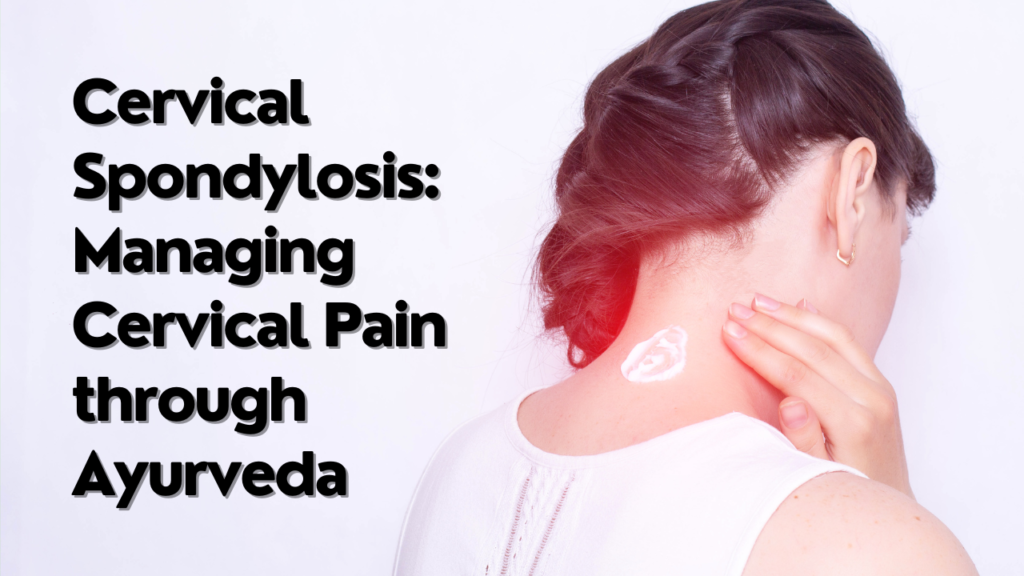Cervical spondylosis is a condition characterised by the degeneration of the spinal discs and joints in the neck region. It can cause various symptoms, including neck pain, stiffness, headaches, and numbness or tingling in the arms or hands. While conventional medical treatments such as pain medications, physical therapy, and surgery may be recommended in severe cases, Ayurveda, a traditional system of medicine from India, offers alternative approaches to managing cervical pain.
Ayurveda views cervical spondylosis as an imbalance in the body’s doshas, particularly Vata dosha. According to Ayurvedic principles, Vata dosha governs the movement and functioning of the nervous system, and its imbalance can lead to pain and inflammation in the neck area.
In Ayurveda, the management of cervical spondylosis focuses on restoring the balance of Vata dosha and reducing inflammation.
Here are some key approaches used in Ayurvedic treatment:
Panchakarma: Panchakarma, through its therapeutic procedures which are practised at some of the best Panchakarma treatment Centre such as Abhyanga, Swedana, Basti, Nasya, and Virechana, helps manage cervical spondylosis by reducing pain, inflammation, and stiffness in the neck and shoulder region. Abhyanga improves blood circulation, while Swedana promotes the elimination of toxins. Basti nourishes tissues and balances Vata dosha, and Nasya alleviates sinus-related symptoms. Virechana eliminates excess doshas and toxins, reducing inflammation. Together, these Panchakarma procedures detoxify the body, improve muscle function, enhance circulation, and restore balance, providing a holistic approach to managing cervical spondylosis. It is essential to consult with an Ayurvedic practitioner for personalised treatment.
Ayurvedic Medications: Ayurvedic medications play a crucial role in managing cervical spondylosis by addressing pain, inflammation, and strengthening the affected area. Herbal formulations like Shallaki, Guggulu, Ashwagandha, and Shatavari are commonly used by the Ayurvedic Doctors in Prayagraj. Shallaki and Guggulu possess anti-inflammatory properties, reducing swelling and pain. Ashwagandha acts as an adaptogen, helping the body manage stress and supporting the nervous system. Shatavari aids in nourishing and rejuvenating the muscles and tissues. These Ayurvedic medications help improve the overall condition of the neck, reduce discomfort, promote healing, and support the body’s natural ability to recover from cervical spondylosis. Consultation with an Ayurvedic practitioner is recommended for appropriate dosage and personalised treatment.
External Therapies: External therapies in Ayurveda provide beneficial effects in managing cervical spondylosis by targeting the affected area directly. The application of Ayurvedic oils on the neck and shoulder region helps alleviate pain, reduce inflammation, and improve flexibility. The oils are often used by many of the best Ayurvedic practitioners of the Joint Pain Treatment Centre in Prayagraj in Abhyanga (therapeutic massage) or as part of Ayurvedic massages. The therapeutic properties of the oils, such as anti-inflammatory and muscle-relaxing properties, help relieve muscle tension, enhance blood circulation, and promote healing in the cervical spine. External therapies provide localised relief, improve range of motion, and contribute to the overall management of cervical spondylosis. Consulting an Ayurvedic practitioner can ensure the appropriate selection and application of external therapies.
Yoga and Pranayama: Yoga and Pranayama offer valuable benefits in managing cervical spondylosis by improving flexibility, strengthening muscles, and reducing pain and stiffness. Specific yoga postures targeting the neck and spine, such as neck stretches, gentle twists, and shoulder rolls, help increase mobility and relieve tension in the cervical region. Pranayama, the practice of controlled breathing exercises, promotes relaxation, reduces stress, and enhances oxygenation to the affected area, aiding in pain management. Yoga and Pranayama also contribute to overall well-being, improve posture, and alleviate associated symptoms like headaches. Practising these techniques regularly under the guidance of a qualified instructor at the best Yoga Centre In Prayagraj can significantly support the management of cervical spondylosis.
Dietary and Lifestyle Modifications: Dietary and lifestyle modifications play a crucial role in managing cervical spondylosis by promoting overall well-being and reducing inflammation. Ayurveda emphasises a balanced diet and lifestyle to support healing. Avoiding foods that increase Vata dosha, such as cold and dry foods, and incorporating warm, nourishing foods into the diet helps reduce inflammation and promote tissue repair. Additionally, maintaining a regular sleep pattern, managing stress levels through relaxation techniques, and incorporating gentle exercises into daily routine support the management of cervical spondylosis. These modifications enhance overall health, support the body’s natural healing processes, and contribute to long-term management of the condition. Consulting an Ayurvedic Doctor can provide personalised dietary and lifestyle recommendations.
It’s important to note that Ayurvedic treatments should be personalised based on an individual’s constitution (Prakriti) and specific symptoms. Consulting a qualified Ayurvedic practitioner is recommended to receive tailored recommendations and guidance.
While Ayurveda can offer complementary support for managing cervical spondylosis, it’s crucial to consult with your primary healthcare provider and follow their recommendations for diagnosis, treatment, and monitoring of the condition. Integrating Ayurvedic practices with conventional medicine can provide a holistic approach to managing cervical pain and promoting overall well-being.
Conclusion: In conclusion, Ayurveda offers a holistic approach to managing cervical spondylosis and its associated pain through various modalities. The principles of Ayurveda focus on restoring balance, reducing inflammation, and strengthening the affected area. Panchakarma therapies help detoxify the body and alleviate symptoms, while Ayurvedic medications provide natural relief and support healing. External therapies, yoga, and pranayama enhance flexibility, reduce pain, and improve overall well-being. Additionally, dietary and lifestyle modifications contribute to long-term management by reducing inflammation and promoting a healthy lifestyle. Integrating Ayurvedic practices with conventional medical treatments can provide a comprehensive approach to effectively manage cervical pain and improve the quality of life for individuals with cervical spondylosis.
